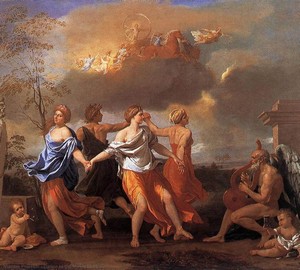
Description of the picture:
Dance to the music of the time – Nicolas Poussin. Canvas, oil. 82 x 104 cm
As is characteristic of the artists of classicism, Poussin refers to the plots of ancient mythology when painting. In the center of the canvas are four dancing in a circle, holding hands, figures. The artist depicted:
- Poverty
Located in the background, turned to the viewer with his back, is the figure of a young man in a green tunic and in a wreath, whose leaves wilted – Poverty. The figure to the right – a woman with a somewhat rude face, in simple clothes relative to the other two figures and a headdress of earthy tones – personifies Labor. The third figure in the center of the picture is Wealth: gold-like clothing and jewelry woven into the hair reflect wealth. The figure of a slyly looking girl on the left with a wreath of roses on her head, which has a hedonistic appearance, symbolizes Pleasure (or Luxury).
It should be noted that Labor and Poverty have no shoes, the artist gave them a restless and tired look – as opposed to the calm and contentment of Wealth and Luxury, which pushed the first two to the background. Obviously, the figures symbolize the course of human life and the change of its states – a round dance spinning like the wheel of Fortune.
The space of the picture is limited to the left by stone structures – a slab and a pedestal with a statue of a two-faced Janus, looking simultaneously to the left (into the future) and to the right (to the past), and a pillar to the right. There is also a beautiful landscape in the background, trees on the left, between the round dance and Janus. Everything is located and depicted extremely harmoniously and symmetrically.
To the right of the round dance sits Chronos in the image of an old man with wings playing the lyre. He personifies Time – the figures succeed each other, and the states of a person pass one into another like seasons (Poverty corresponds to autumn, Labor corresponds to winter, and Wealth and Pleasure correspond to spring and summer, respectively).
Time also looks at the figures rotating in the dance with a sly smile, reflecting the feeling of mortality, transience, the decay of life and the inability to leave the circle or control the dance under the life-defining game of Time.
There are other details that are important for understanding the picture. In the sky above the dancing figures there is a mythological image of the chariot of Apollo (Apollo holds a circle – the Zodiac is a symbol of continuous continuation of life) – the colors of her and the horses harnessed to her echo the clothes of the dancers. Aurora scattering flowers flies in front of the chariot, personifying the dawn – this image emphasizes the figure of Wealth (spring, flourishing, dawn) that is being held at this moment in the foreground in the very center of the picture – the present moment.
At the same time, two babies are located in the lower part of the picture: one at the feet of the winged Chronos, who is looking at the hourglass in his hand, which indicates that Spring (prosperity, wealth, prosperity) on the right side of the picture is temporary; another baby is sitting under the statue of Janus and very close to the unfolding figure (closing the circle and holding the hand of Poverty) of Luxury (Pleasure, Pleasure) and is amused by blowing soap bubbles – a symbol of fleetingness, the ephemerality of life and the illusory nature of happiness.
Thus, on this canvas, Poussin depicted an allegory of human life with ascents and falls, flowering and fading."